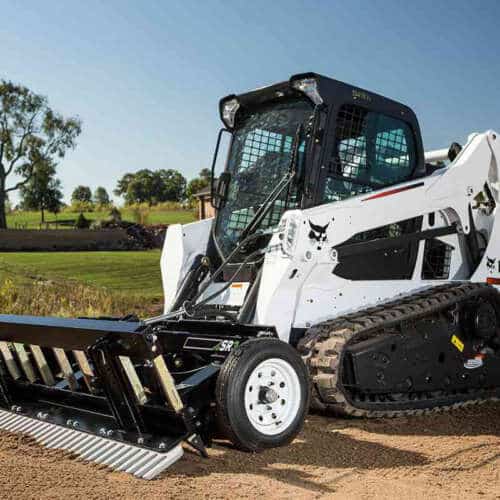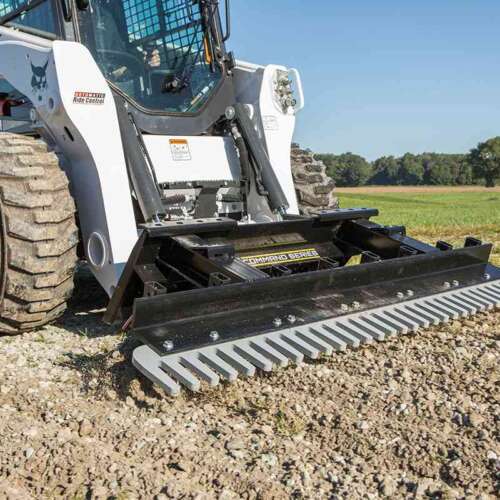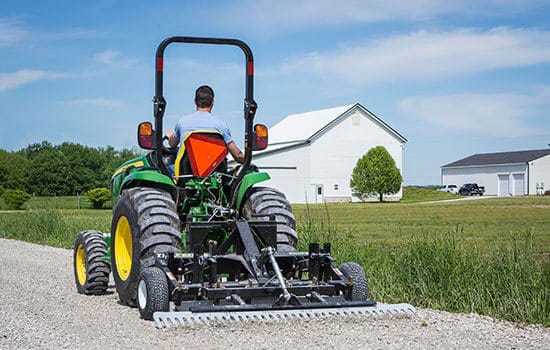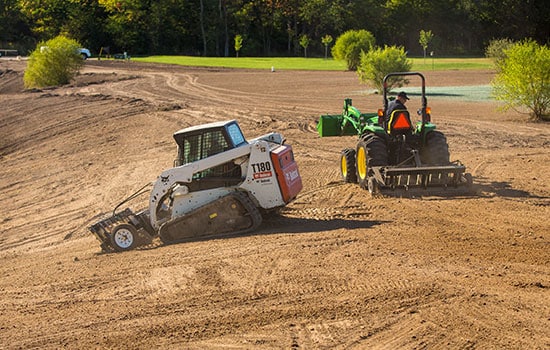Skid Steer Attachments: What’s The Difference Between SR3 & SR1?
ABI Products Shown In This Video

SR3 Grading Rake
- Starting At: $218/mo.*
- For Skid-Steer Loaders (SSL) & Compact Track Loaders (CTL)
- 7.5' Width - Commercial-Duty

SR1 Grading Rake
- Starting At: $82/mo.*
- For Skid-Steer Loaders (SSL)
- 6.5' Width - Commercial-Duty
Transcript
Hi everyone. Matt Metzger here with ABI Attachments. Welcome back to the ABI Dirt. It is getting chilly here in Northern Indiana. Some of you have even gotten your first snow of the season which is terrifying. And if you are someone who has some dirt work to do around your property, either taking care of those gravel driveways or working in the back 40, or if you’re a contractor who’s trying to squeeze in a couple of more jobs yet this season, you might be feeling a little stressed, which is why I want to spend the next couple of episodes here on the dirt taking a look at two products that are specifically designed to help you maximize your efficiency and help you get your work done with less man hours. And we’re taking a look at the SR3 and the SR1. We’re going to put them side by side because at first glance they look really similar, but they’ve got a couple of different ground engagement component differences that I want to highlight so you know which tool is right for you to help you get your work done.
Let’s take a closer look. So here we are with our skid steer rakes, the SR1 and the SR3, in this first part of this multi-part series on these two units, and we’re going to talk about frame sizes, dimensions, weight, why it matters and which might work best for you in your application. Tangent: if you’ve got a mini skid steer or you rent one on a regular basis, when you’re done watching this video, check out our mini SR3 and mini SR1. We’re not going to cover those products in this segment, but we’re going to do some future shows on those. Remember those come with both universal and Bobcat attachments so we can take care of you no matter which mini you drive. But for full-sized skid steers, we’re going to be taking a look at the SR1 and SR3. Let’s check it out.
We’re going to start here with our SR1. The SR1 starts out with a half inch angle iron right next to your attachment plate. You get a three eighths inch I-beam running down the sides and you’ve got another half inch angle that attaches to the three quarter inch abrasive resistant rake.
Now that rake is six and a half feet wide, so it’s a little bit more maneuverable when you’re trying to get into tight places right up next to a house or up to concrete pads. You’ve also got on this SR1 your ripping teeth with your standard nine inch shank, inch and a half bolt-on replaceable scarifier tip that you can see in the holes here. You can adjust by one inch to get you anywhere from out of play at zero inches down to four inches deep.
This unit weighs in at 460 pounds which means it’s ideal for your smaller or older skid steers and track loaders. Now over here on the SR3 you can see we’ve got a lot more going on. You still have your half inch angle iron upfront with your three eighths I-beam down the sides with an additional three eighths I-beam in the center of the tool. And you still got your half inch angle here on the bottom that attaches to your three quarter inch rake.
Now this unit weighs in at 1300 pounds, so about triple of what the SR1 does. That weight comes predominantly from a center leveling bar with hinged rock teeth as well as a top weldment for your hydraulically controlled scarifiers, which brings me to the point of talking through the different ground engaged components. Whereas the SR1 just had your manually controlled scarifiers and your finished rake on the far front end, the SR3 has got a couple of more components. You can see right off the bat that we’ve got a 19 inch foam filled tire, and remember at ABI, tires aren’t tires, they’re stabilizing wheels, as well as the addition of what I mentioned earlier, that big leveling blade in the middle of the tool, which we will talk about in future episodes.
So because of the heft of this tool, because of the ability to hydraulically control your ripping teeth, control the depth, which because of the adjustments you can get all the way down to seven inches deep if you adjust everything correctly, and because of the addition of the ability to level, this tool is a contractor’s dream.
This is what allows you to rip and level and finish a soil space so that it is ready for ideal seedbed or for gravel application. In future episodes we’re going to go piece by piece, component by component to let you know how all of these components interplay to give you the best results for your soil as well maximize your efficiency and save time. But I wanted to start out here with the two units, talking through the frame, so you can get an idea of how big these units are and how heavy they are so you can begin to think about what you need to accomplish, how often you’re going to use it and whether or not you need the additional muscle supplied by that SR3.
That’s all I’ve got today everybody. I hope this introductory look at the SR3 and SR1, the side by side, was helpful. As always remember, if you don’t want to miss the rest of the episodes in this series on these two tools, click that subscribe button. That way you can follow along, you get the email next time around. And also remember if you want to take a look at the spec sheets yourself, we’ve got all those details online. You can take a look by following the link on this video. See you next time.



